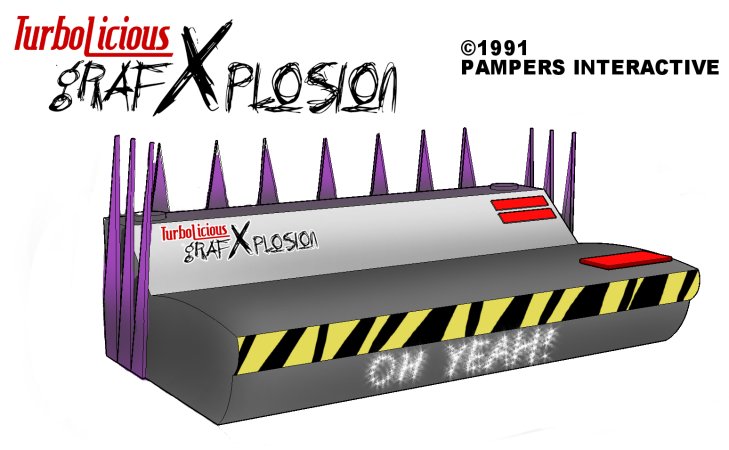
Hey you, person reading this! Are you currently the CEO of a Fortune 500 corporation and think breaking into the hardcore video game market would be a walk in the park? Think again! For every blockbuster success like the Playstation or Wii, there's about six or seven Apple Pippins or Infinium Phantoms. Read about the worst of them here.
It's not easy to establish a game console at all. Many have tried, most have failed -- even companies that you'd never expect to be interested. There once was a day when Procter and Gamble, makers of all sorts of household products, threw their hat in the video game ring. Lacking experience connecting to the gaming market -- then predominantly children -- P&G turned to its diaper division and asked it to start experimenting with an audience slightly older than their usual. The end result? The most outrageous, attitudinous, overbearingly radical gaming system of the early 90's....the Turbolicious GrafXplosion!

Only the utmost of attention was provided on making the Turbolicious GrafXplosion the coolest-looking console ever. From the jagged fins on the edges (that publicity brochures claimed were sharp enough to really cut you, making them the epitome of cool), to the shell designed by an NBA basketball star, to the "OH YEAH!" written on the front of the machine in glitter, it packed more concentrated in-your-face than any other product.
This was the age when no one was sure which kind of media video games should be released in. Thanks to Nintendo, the prevailing medium was cartridges, though some consoles were beginning to take CDs. The TurboGrafx took data cards, and the Commodore 64 took cassette tapes. You might have even heard of that toy company that released a console which ran on VHS tapes. The Turbolicious GrafXplosion did things a little differently. It was the only console to run on vinyl records.
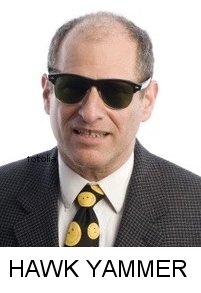 |
Turbolicious' loud-voiced spokesman, Hawk Yammer, publicly claimed this decision was a major selling point for the system. "It is true that CDs are the newest thing, but records are in more American homes than any other product," he boasted. "People are more afraid to take a chance on the unfamiliar. But they already know how a record player works. We have familiarity on our side, and therefore the edge." There was at least one advantage to that: the console could be hooked up to any record player, and so a much cheaper model was sold without one. That model, though, still cost $400. |
| Despite the game industry leaning toward crosspads, the Turbolicious game controllers brought joysticks back, plus an additional twelve buttons, some of which lit up. These controllers would be revised later, repeatedly, throughout the system's shelf life until finally a vaguely normal controller was sold right before the end. Those unpainful controllers are highly sought after now. | 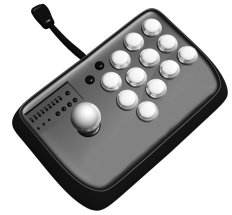 |
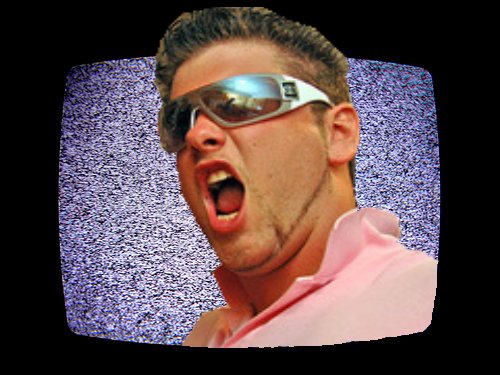
The Tubolicious GrafXplosion hit US markets in the fall of 1992. In the console's first TV spot, a tweenage child is sitting in front of a large TV in a dingy dilapidated room, playing the NES. Suddenly, before we can see what game he's playing, his screen turns to static, then gains the face of a scowling square-jawed man in sunglasses. The man screams, "YOU STUPID MORON!!! YOU WASTE OF AIR!!! YOU'RE A DISGRACE TO HUMANITEEEEEE!!!" He then leaps out of the TV and beats the kid with a baseball bat. Then he thrusts the bat into the air triumphantly and roars like a lion so loud the entire house explodes, then the view pulls back to show the entire GALAXY exploding. A blur of game screenshots appear a tenth of a second at a time, then the slogan hits with a deep-voiced growl: "TURBOLICIOUS. TASTE THE POWER." Cue logo.
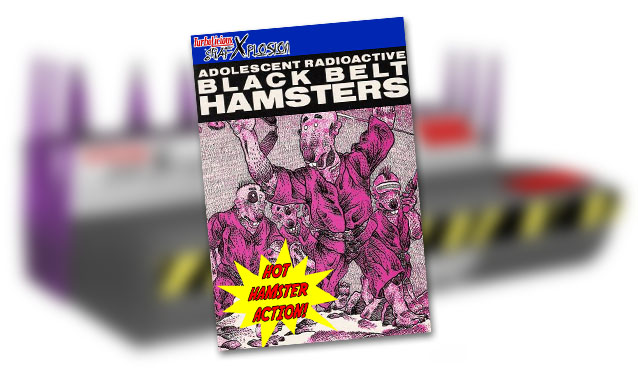
Packed in with the original Turbolicious model was what Hawk Yammer considered the machine's first killer app, a game based on the independent comic Adolescent Radioactive Blackbelt Hamsters. Said Yammer, "From the same form of periodical that brought us the Teenage Mutant Ninja Turtles comes the next big popular trend! The Blackbelt Hamsters are just as bad and rad as the Ninja Turtles, only better. Turtle Power is yesterday's news. Get ready for Hamster Power!" Though most Turtles games were brawlers, the ARBH game resembled Super Mario 3 in almost identical ways, right down to a powerup that put your Hamster inside a giant shoe. Critics gave the game mediocre ratings, but acknowledged the Turbolicious's only real advantage: password codes were not needed because by adjusting the record player's needle, you could skip to whatever level you wanted to.
Other games either available on launch or close to launch included Dream Holes, the FMV golf game. Grown-up and probably-retired players were encouraged to use their imaginations to pretend they were hitting a perfect game with hole-in-ones every time, because that is what the game automatically showed. The back of the box touted it as a great self-esteem builder. One week after launch, Where in the Galaxy is Roofus Rollfus was released: a Carmen Sandiego ripoff, only not educational at all since most of the planets he stole from were made up. Other launch titles: 7up Spot Racing, Skateboarding with Willie Aames, and a vinyl encyclopedia.
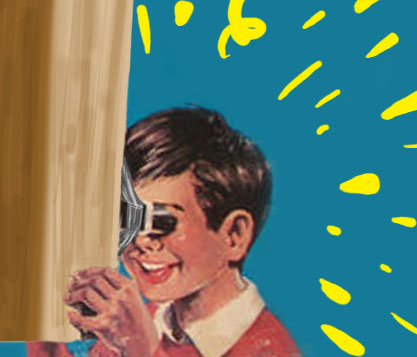
A peripheral device for the Turbolicious, called the StereoscopiXplosion 3-D, came out in the spring of 1993. By attaching the enclosed StereoscopiXplosion to the middle of your TV set's picture tube with duct tape, one could look through it using specially marked games and play them in living three dimensions. The pixel quality, however, suffered, and having to clean the TV screen of adhesive gunk every time your parents wanted to watch Northern Exposure was unpleasant. Only three games used the peripheral: the simple minigame collection that came with the device, a game delayed from the 1992 holiday season based on the Robin Williams movie Toys, and Wheel of Fortune.

Additional add-ons for the Turbolicious GrafXpolosion, sold separately, turned the console into a portable device. The handle and grips, shown attached here by hot glue, made lugging the machine into your car's backseat or behind a long DMV line easier. A 6" television screen replaced your home TV, and the large plastic sheath underneath housed 35 D-cell batteries, which gave up to 2 1/2 hours of uninterrupted gaming pleasure. Another additional add-on turned the 6" screen into a real analog TV, but at the expense of battery life. There was also a planned electric typewriter add-on, to increase adult appeal, but this didn't make it past testing.
As the months went by and the Turbolicious failed to get a toehold, the advertising turned even more aggressive, directly targeting the competition. Despite what it's name implied, the GrafXplosion's graphics capabilities paled in comparison to those of the SNES and Genesis. They couldn't gain the edge by comparing CPU speed or game libraries either, so instead a series of ads appeared touting the heaviness of the machine. "THE TURBOLICIOUS IS HEAVIER THAN ALL THESE OTHER WIMPS COMBINED!!" a macho man bellowed, while standing in front of a seesaw that easily lifted every competing machine with a Turbolicious at the other end. "THAT WEIGHT IS ALL TECHNOLOGY, BABY!!" The other consoles flew away comically in the wind, while the Turbolicious remained. While the Turbolicious was indeed one of the heaviest consoles, the company's bloated figures counted the record player in the weight measurements, and the biggest record player they could find.
The pack-in game wasn't attracting consumers either. Their Adolescent Radioactive Blackbelt Hamsters license was about to expire anyway, so they replaced the game with something else, selling it on the open market with the new title "Youthful Nuclear Samurai Rodents." Filling the hole in its place was an attempt to brand the Turbolicious with its first mascot. Seeing the amazing graphics of full-motion-video games as the wave of the future, the company launched a game starring the first FMV live-action mascot character, Badical Bruce.
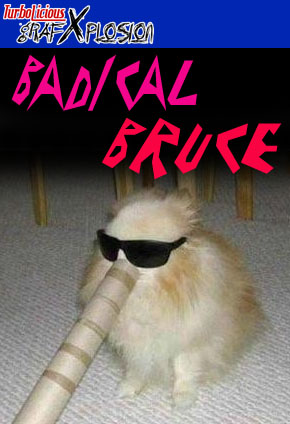
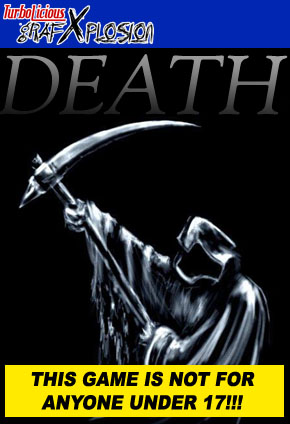
But not even this was saving the ship from sinking. As sales of the Turbolicious, never all that spectacular, started to seriously wane, Yammer noticed the rising debate over controversial games such as "Night Trap" and decided his console had to have its own. Six months later "Death" was released: a game in which you controlled the Grim Reaper on a 2-D sidescrolling plane, walking around a city and touching random sprites of people to make them fall down and die. Despite the edgy premise, critics and consumers alike called it "boring." It didn't cause the uproar Yammer had hoped for, and desperate to stir the pot, he reportedly sent a copy to a prominent US senator with a letter begging him to make the game into a moral issue. A revised version was hoped to sell more copies by making the people Death touched explode in blood, but it did not make it past prototype before the Turbolicious market shut down for good.
Eventually, the inevitable happened: shortly before the Summer 1994 CES, Hawk Yammer stepped down from his perch, amid rumors he was about to be fired anyway. At CES the division's new president took the stage instead, and with his next breath, told his investors "if any of you put any money into the Turbolicious in the last few months, you're screwed." He then unveiled a prototype sketch of a proposed replacement system, the T-2, that used Laserdiscs and could also play SNES, Genesis and 3DO titles. Nothing was heard from the project or the president again. The last game released for the Turbolicious GrafXplosion, in November of 1994, was a port of Plumbers Don't Wear Ties that was vastly inferior to the 3DO original.
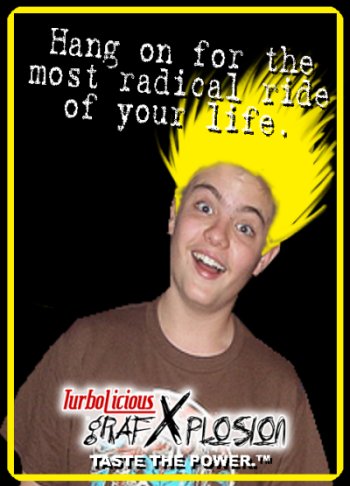
Today, video game collectors seek out the Turbolicious for its few good titles: the best version of Boogerman ever released, the extremely rare and valuable JRPG Fantatopia (of which only 47 copies were sold), and "Tomb Raider" creator Toby Gard's first game, Mr. Floopypants Kicks Dr. Awfulpants's Butt Seriously Hard. The Turbolicious also has an active homebrew community that continues to this day, though finding vinyl record burners can be difficult and expensive.
Today, Hawk Yammer is president of the small Internet-based company NerkYam.com, which he co-owns with fellow entrepreneur George Nerk. He refuses to give interviews, and he regards the Turbolicious GrafXplosion as a dismal failure -- except in the Phillipines and the island nation of Fiji, where it was a hit for some reason. To this day, roadside stands in Fiji still sell bootleg versions of the console, called "Turdlicus Grafaplodon."